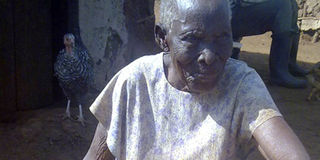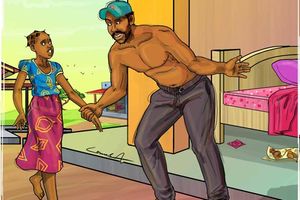Prime
At 116, Kween grandma could be Uganda’s oldest

Ms Kokop Sindet Chesha Kurus at her home in Sosto Village, Ngenge Sub-county, Kween District. PHOTO BY DAVID MAFABI
On a hot Saturday afternoon on August 25, I bend to enter a mud-and-wattle hut in Sosto Village, Ngenge Sub-county in Kween District. Mission? To meet 116-year-old Kokop Sindet Chesha Kurus who could be Uganda’s oldest person.
Even in her advanced age, Sindet is neat and keeps her gray hair short and well-trimmed. Her frail look, however, reveals her advanced age and weakness as she struggles to sit on the ground.
Her two grass-thatched hut sits at the foot of Ngenge Hill that spreads across like a green bed; one hut serving as a kitchen while the other served as her main house.
Sindet smiled as I entered her hut. She welcomed me in and searched for what I could sit on unsuccessfully before she told me to move out.
Augustine Kerenget, 91, who is Sindet’s son says his mother could be 116 years old or more. “From my conversation with her, she should be about 116 or more. She told me when her she came to Kapchorwa from Kenya in 1907, she was about 10 years old,” Kerenget adds.
During the interview, I notice that Sindet’s memory could be fading. At first, she could not recognise her only surviving son Kerenget, who guided us through the Ngenge Hills to where she stays.
“I don’t know my age but all my children who have died, I know their ages,” says the old woman. “There was Kokop Cheprui who died at the age of 91 in 2006, but the first two died in 1971 and 1978 respectively,” says Sindet.
“But what I recall very well is that those days Sabiny girls circumcised at about 11-15 years before getting married and I could have got married at the age of 20,” says Sindet.
She says although she goes to church sometimes, she was never baptised by the “religion that was brought by the Mzungu” [whites]. “My father Tituk Chemaswet who died around the end of Second World War told us the white man had come to rob us and asked us never to use anything of the whites, not even names,” she says.
Kerenget, who occasionally interrupts his mother during the interview, says he was born a year after World War I and that at that time, their mother had produced two other children, her first born child Isaiah Kerenget, who was about six years then.
“She tells us stories about the origin of Female Genital Mutilation and how they crossed from Kenya to Uganda when she was a young girl. Records here indicate that the Sabiny could have crossed into Uganda in 1910, this was before she got married which helps us tell her age,” explains Kerenget.
Sindet has sharp memories of her early childhood. “I grew up as a good, decent woman. I didn’t move around with men and it was only after female circumcision that the man who wanted me came for me, I agreed and we got married,” she says.
Asked about her peers who are still living, Sindet says most of them were killed by Karimojong cattle rustlers and others died natural death but there are those who are still living in Bugiri District.
She says they went there at the beginning of cattle raids, but does not recall the year.
According to the Uganda Bureau of Statistics (Ubos) data survey of 2009, the oldest living person in Uganda was 114 years at the time.
The New Vision article named Gabriele Osele, 103, of Bukedea, as one of Uganda’s oldest people in 2009 and the Observer newspaper named Agali Nesiga; at 115 as the possible oldest person in 2009.
The BBC recently reported that at 130, Sohan Dosova of Kazakhstan could be the world’s oldest person. Ubos says in a 2009 report that at the last census, 7.1 per cent of the people in Bukedea were aged 60 and above, making it the district with the oldest population. At sub-county level, Bumasifwa leads with 8.6 per cent; with the eldest person in the sub-county aged 114 years.
Unlike Sindet and Nesiga, who cant tell their exact age, it was easier to tell Sohan Dosova’s age for certain because of her Soviet passport indicating that she was born on March 27, 1879.
For Sindet, her age can be guessed basing on her memory that her family crossed into Uganda in early 1900s and that by then, she was close to or more than 10 years old.
They settled in Ngenge Sub-county in the newly-created Kween District and lived in eastern Uganda all her life.
“I have no stress; even after my husband died in 1940s. People usually go to an early grave because of hardships and stress,” she says. Sindet explains that she has never taken any Western/modern medicine.
“I occasionally take alcohol but I mix it with local herbs,” she says, adding that her life has been peaceful and “without conflict”. She says she grew up eating millet or maize bread, roasted meat, milk butter and local sodium bi-carbonate as salt, which have enabled her to stay strong.
Those close to Sindet testify that she hardly falls sick. Although she had swollen feet during the time of the interview --the only sign of ill-health noted, Sindet says she does not see clearly like in the past.
When she smiles, her wrinkled face is lit up by the white set of teeth, all of which are still intact. When asked if she has ever visited a dentist or hospital, she laughs and says: “Have never seen one (dentist) in my life. I just eat a lot of natural foods and greens with no sugars and oil.”
Other than eating good food, Sindet is also a hard worker. Every morning, she walks two kilometres up the hill, to attend to her goats. She recalls that as a young girl, she and her colleagues would join the boys to go hunting in Ngenge Hills and at the slopes of Mt. Elgon.
Speaking about marriage and fidelity, Sindet says: I didn’t move from one man to another like most girls these days, they are immoral that explains why the Sabiny circumcise girls to cut down their libido.”
She says although she was in a polygamous marriage, there was no stress and “no conflict as we were trained to cook food for our husband and the entire family with my co-wives in turns.”
Medical explanation
The Kween District Health Officer, Dr Kenneth Chemutai, says residents in the area live long due to the cool temperatures and the hilly terrain that encourages people to exercise.
“In such hilly areas, there are normally no reported cases of malaria that threaten the lives of the people. The people gather vegetables in the forest to cook and the frequent climbing of the hills strengthens their muscles,” says Dr Chemutai.
The MP of Kween, Mr Kisos Chemaswet, says he has known Ms Sindet for long and that his great grandfather would occasionally talk about her in the early 1980s. “This woman is old because our great grandfather died above the age of 80 in 1985 and used to talk about her when we were young but she remained living to-date. She is old and is the encyclopedia for Sebei culture because she know everything,” says Chemaswet.
According to the survey, whereas people can do many things to live long and healthy lives, the places we live in also shapes our health and lives.
==========================================
Age distribution
Regional. At regional level, eastern Uganda leads with 5.3 per cent oldest people followed by western with 4.4 per cent central 4.4 per cent and northern 3.9 per cent.
Districts. In Buganda, Mityana District leads with 6 per cent while in the west, Kisoro leads with 5.5 per cent. In the north, the regional giant is Nebbi, with 4.8 per cent.
Sub-counties. Sub-counties with persons aged 60 per cent and above include Bumasifwa in Sironko, Ngenge, Buwalasi in Sironko Malera in Bukedea, Omodoi in Katakwi, Kalungu in Masaka, Busoba in Mbale, Buyobo in Sironko and Kolir in Bukedea 1,257 7.5.




